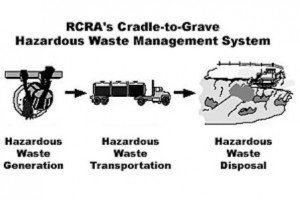While most of the regulated community have some knowledge of the applicable regulations which with they must comply; and a passing familiarity with USEPA Guidance and Policy Documents; and a vague awareness of the law upon which they are all based; many lack a complete understanding of the relationship of these resources to their responsibility as a generator of hazardous waste. The purpose of this article is to explain the role of these three elements: the Resource Conservation and Recovery Act, the USEPA – and State – regulations, and Guidance & Policy Documents of both the USEPA and your state.
The Act:
The Resource Conservation and Recovery Act (RCRA) began as a bill passed by Congress and signed into law by the President Gerald Ford in 1976. It was not the first statute to specifically focus on identifying solid waste and improving methods for its management and disposal; that honor belongs to the Solid Waste Disposal Act of 1965. RCRA amended the SWDA and created the framework for the hazardous waste management program in effect today. While not critical to compliance for most hazardous waste generators, the most important accomplishment of RCRA was the establishment of general guidelines for the identification and management of all solid waste – which includes hazardous waste – in a way that protects human health and the environment, conserves resources, and encourages recycling.
One of the general guidelines Congress included in RCRA and is reflected in the regulations is the concept of cradle to grave management of hazardous waste. |

And…
- Empowered the USEPA to turn the broad guidelines of RCRA into enforceable regulations. RCRA also empowered the States to create their own enforceable regulations to achieve the goals of RCRA. To be authorized, State hazardous waste programs must be at least as strict and as broad as those of the USEPA.
RCRA has been amended many times since 1976; notable amendments to RCRA include:
- Hazardous Waste Solids Act of 1984
- Federal Facilities Compliance Act of 1992
- Land Disposal Program Flexibility Act of 1996.
RCRA
The law that describes the kind of waste management program that Congress wants to establish. RCRA also provides the administrator of EPA (or his or her designee) with the authority to implement the program.
The Regulations:

The first USEPA regulations, or rulemakings, based on RCRA were published in the Federal Register on May 19, 1980 (4 years after passage of RCRA!). It is the regulations that translate the general guidelines of RCRA into specific, enforceable requirements for the USEPA and the regulated community. The regulations are created in an open process that allows for input from any interested parties (Read: The Rule Making Process). This open process of rule creation and the public access to the completed regulations justifies the USEPA’s position that ignorance of the regulations is no excuse. “It’s out there” is the USEPA’s response to, “Well, how should I have known that?!” Read my article: The structure of the Code of Federal Regulations to understand what you’re looking at when you read the CFR.
REGULATIONS Legal mechanisms that establish standards or impose requirements as mandated by RCRA. RCRA regulations are formally announced by USEPA, published in the Federal Register, and codified in the Code of Federal Regulations (CFR). |
When it comes to compliance, knowledge of the regulations based on RCRA is a must for anyone in the regulated community. Currently, the RCRA regulations occupy Parts 239-282 of Title 40 of the CFR. In states with an authorized hazardous waste program, state statutes may replace or amend RCRA.
Sometimes, though, the regulations are not clear or don’t address your specific circumstances. That is when you must refer to Agency Guidance and Policy.
Guidance and Policy:
Guidance and Policy are actually two distinct but similar sources of information issued by the USEPA to assist the regulated community in complying with the general guidelines of The Act and the specific requirements of the regulations.

Guidance Documents are issued by USEPA to provide direction in complying with the regulations. They may take many forms but are essentially “how to” documents to indicate what is required to comply with a particular regulation or to elaborate on the USEPA’s interpretation of the general guidelines of RCRA.
GUIDANCE = How to Documents developed and issued by USEPA to provide instructions on how to implement the requirements of either RCRA or regulations. | POLICY = Should do Statements developed by USEPA outlining a position on a topic or giving instructions on how a procedure should be conducted. |
Policy Statements specify operating procedures that should be followed by the regulated community. Whether directed to the regulated community or directly to the USEPA staff working on implementing a particular regulation, Policy Statements indicate what a hazardous waste generator should do to comply with the regulations.
So what does it all mean?
RCRA (aka: The Act) sets the standard for what the Federal government – representing “We the People…” – wish to achieve. Laudable goals like: cradle to grave management of hazardous waste or banning the open burning/dumping of solid waste. It doesn’t, however, provide much assistance in attaining and maintaining compliance with the regulations.
The regulations (40 CFR Parts 239-282) are the enforceable rules that must be followed by those within the regulated community. Usually, the text of the regulations – if read carefully – will tell you all that is necessary to attain and maintain compliance. Examples include the accumulation time limits of 40 CFR 262.34 for generators of hazardous waste where you’ll find the requirement for generators of hazardous waste to provide training for applicable personnel*.
Guidance Documents and Policy Statements can fill in the gaps of understanding left by the regulations. The regulated community should use them to supplement the regulations and to better understand what the USEPA wants from them.
Remember that your state may create its own version of all of these. Be sure to check with your state environmental agency to ensure compliance.
Daniels Training Services 815.821.1550 |
*And don’t hesitate to contact me for a free consultation on the training you are required to provide for your employees.
